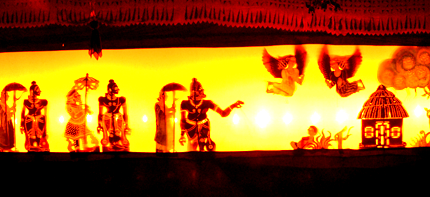Tholpavakoothu is a traditional art form performed at bhadrakali temples palakkad malappuram thrissur districts.Tholpavakoothu performed in temples at a permenent stage called koothu madamsin front of badhrakali temples.
It is said to have originated in the 18th century is also known as pavakoothu (puppet play) or nizhalattam (shadow play). This entertainment art is performed on a special stage called koothumadam in the temple courtyard. Puppets (pavakal), usually representing four characters from the Ramayana, are arranged behind a long white screen, in front of bright wick lamps. The puppets made of deer skin are made to dance to songs from the Kamba Ramayana (the Tamil version of the epic). The performance starts late at night and continues up to daybreak. Tholpavakoothu, literally meaning ‘leather puppet play’, is a ritual art performed during the annual festivals in the Kaali temples of Palakkad district. The theme of the play is based on the Kamba Ramayana, narrated in a diction that is a mixture of Malayalam and Tamil dialectical variations. The play covers the whole gamut of events from Lord Sree Rama’s birth to his coronation as the King of Ayodhya. The shadow play is presented in the ‘Koothumadam’, a specially constructed oblong play house on the temple premises. The puppets are fashioned out of the hides of buffaloes and deer, the former for evil characters and latter for noble ones.
Each puppet is of an average height of 80 cms and is cut out in different postures. The puppets are arranged behind a long white curtain stretched across the Koothumadom. Behind this, on a split bamboo pole, is placed a row of wick lamps burning inside coconut halves. The light from these lamps cast the silhouettes of the puppets on the curtain. The chief puppeteer is known as ‘Pulavan’. At present this ritual art is confined to Ottapalam and Kavalappara in Palakkad district.
Kerala has made a notable contribution towards maintaining and enriching the cultural heritage of India. It has evolved through the centuries a rich and diversified culture which has nourished and become an integral part of culture of India as a whole.
Among the ancient artform of Kerala tolpavakoothu or shadow puppet play occupies a prominent place. It is a fine example of the integration of Aryan and Dravidian cultures.
Most of the Indian art forms their birth and growth to religion. They are therefore intimately connected with modes of worship. In ancient Kerala the religious practices of the people and their moral mode code were based upon derived from Dravidian culture . But gradually new religious practices and ideals entered Kerala from the North. The result was a blending of the Dravidian culture of the south and the Aryan culture of the north which, it is believed ,took place about three or four centuries before Christ as a result of this impact of Aryan religion and culture on the indigenous Dravidian culture of Kerala, Hinduism assumed a new form in Kerala. The influence of this blending of the two cultures, Aryan and Dravidian can be seeing in religious life of people but also in the arts.
Among the ancient artform of Kerala tolpavakoothu or shadow puppet play occupies a prominent place. It is a fine example of the integration of Aryan and Dravidian cultures.
As a part of the geographical region Tholpavakoothu is fully consists in the areas of the river Nila (Bharatha puzha).
Puppets
The puppet plays are based on selected verses from the famous Tamil Epic ”Kamba Ramayana’. The language used is a dialect of Tamil with an admixture of Sanskrit and Malayalam words.
The Puppets are made of deer skin and are held by a thin stick in one hand while the limbs are manipulated by a thinner stick held in another hand of the puppeteer.
About 160 puppets are used for the complete version of the “Kamba Ramayana”, representing 71 characters in four main categories (sitting, standing, walking, fighting) besides puppets to depict nature, battle scenes and ceremonial parades.
Performances
The screen is illuminated by 21 lighted lamps, made out of coconut shelves, filled with coconut oil, provided with cotton wicks and placed equidistant from eachother on the Vilakku-madam (wooden beam) behind the curtain.
Ezhupara, a cylindrical drum made out of jack-fruit wood and covered with calf-skin on both ends and Ilathalam (cymbals) are the main accompaniments. Shankha (conch), Chenda and Maddalam (drums), Chengila (gong) and Kurum-kuzhal (a short pipe) are further instruments to be used on special occasions.
Depending on the temple tradition, the performance lasts 7, 14, 21, 41 or 71 days. Tolpava Koothu is still performed in more than 100 temples all over Palghat, Trichur and Mallapuram district.
Pulavars
The lead puppeteer is usually a pulavar which is an honorific given to a puppeteer who is also a scholar. Pulavars undergo intensive training in puppetry and have a deep knowledge of Malayalam, Tamil and Sanskrit.
The troupe
The troupe is made by at least eight artists. Although the training is not confined anymore to the Pulavars, all the puppeteers have to be experienced in all branches of knowledge, as the presentation of the story will be full with references to present events and wisdom.
The troupe at Koonathara was founded generations back and revived by the renowned and award winning Tolpava Koothu artist late Guru Krishnan Kutty Pulavar and is now the only surviving puppetry community in Kerala to preserve the art form and train new artists in the traditional repertoire as well as in new productions.
